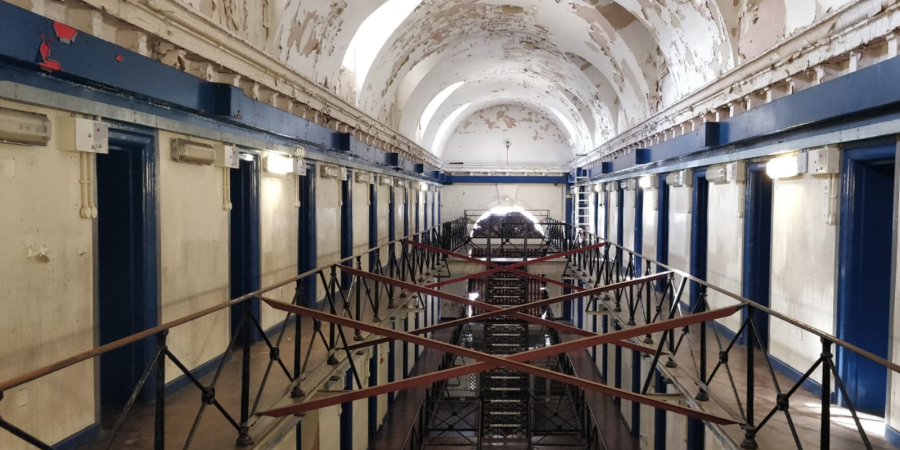In February, Wessex Archaeology excavated a series of trial trenches as part of the redevelopment of the former HMP Gloucester. Senior Fieldwork Archaeologist Cai Mason tells us more about the background of the site, and what has been revealed by the excavations so far…
Gloucester Castle and the Second Baron’s War
The summer of 1265 was a critical moment in British history. A civil war, fought between royalist forces loyal to king Henry III and a coalition of rebel barons led by Simon de Montfort, had raged for over a year, and the outcome of the conflict hung in the balance.
Initially, things had gone well for the rebels: their victory at the Battle of Lewes in May 1264 resulted in the capture of the king and his son and heir Prince Edward, who they incarcerated in Hereford. Unfortunately for de Montfort, Edward soon escaped and managed to form a new royalist army. His forces were soon bolstered by defectors from the rebel cause, including Gilbert de Clare, the powerful Marcher ruler of the Lordship of Glamorgan. To counter this threat, de Montfort formed an alliance with Llywelyn ap Gruffudd, ruler of the Welsh kingdom of Gwynedd, who provided money and troops in exchange for a guarantee of independence for his kingdom.
De Montford’s forces were massed in the Welsh Marches and control of crossings over the River Severn was vital to the outcome of the war. The most southerly crossing was guarded by Gloucester Castle; a formidable Norman-era fortress with a tall square keep, surrounded by high walls, a double line of moats to the east, and the fast-flowing River Severn to the west. Control of the castle had been fiercely contested over the preceding three years and it had changed hands no less than five times, either through battle, defection, or subterfuge. It had been held by de Montfort since December 1264, and its usual garrison of 70 or so English and Welsh men had been reinforced with an additional 300 troops in anticipation of attack by Prince Edward.
Edward was very familiar with Gloucester Castle; it had been one of his father’s main residences and he himself had overseen improvements to its defences, including the digging of a second moat, repairs to its walls and weapons, and the levelling of nearby properties to create a better field of fire following his successful defence of the castle the previous year.
The Royal army arrived in Gloucester on the 10th of June 1265, and quickly breached the town’s weak north wall. After two day’s fierce fighting they had taken control of the town, but de Montfort’s men remained secure behind the castle’s double drawbridge. Edward was prepared for this eventuality and his engineers quickly surrounded the castle with siege engines including trebuchets and mangonel catapults, which began pelting the castle with large rocks and firebombs. This continued for three weeks, during which the keep was set ablaze and partially destroyed. Towards the end of the third week, he launched an all-out assault: first, the moat was bridged, then the gatehouse was burned, and a battering ram was set to work on the gate. Realizing it was only a matter of time before the gate was breached, the garrison surrendered.
The loss of Gloucester was the beginning of the end for de Montford: two months later he was defeated and killed at the Battle of Evesham. This would also have profound long-term implications for Wales. Henry III recognised Llewelyn as the Prince of Wales, but relations soured following Edward I’s coronation in 1274. Llewelyn refused to pay homage to the new king, and he remained allied with the surviving members of the de Montford family. This made him Edward’s enemy, and it eventually led to the invasion, and subsequent conquest of Wales. Llewelyn was killed at the Battle of Orewin Bridge 1282. Edward then built a ring of huge concentric castles round the county, which cemented English control of the country.
But what of Gloucester Castle? Although badly damaged in the siege of 1265, the castle was soon patched up, and it was kept in serviceable condition throughout the medieval period, but with the conquest of Wales, its purpose as a border defence had gone. But Gloucester Castle was not just a fortress: since the late 12th century, it had also served as the county gaol, and by the late medieval period this had become its main use. As a gaol, many of the castle buildings, such as the king’s and queen’s chambers and their associated chapels, were superfluous, and by the end of the 15th century, these buildings had been demolished to retrieve stone for road making. Quarrying of the medieval stonework continued for the next three centuries, and by the 1780s, only the keep, gatehouse and a few other walls remained.
The Old County Gaol
The last standing remains of the castle were demolished in 1787 to clear the site for the construction of a new purpose-built county gaol designed by the William Blackburn, the leading prison architect of the day. Gloucester Prison, as it was later known, closed in 2013, and City & Country Ltd have since drawn up exciting plans to redevelop the site as: 1792 The Old Gloucester Gaol.
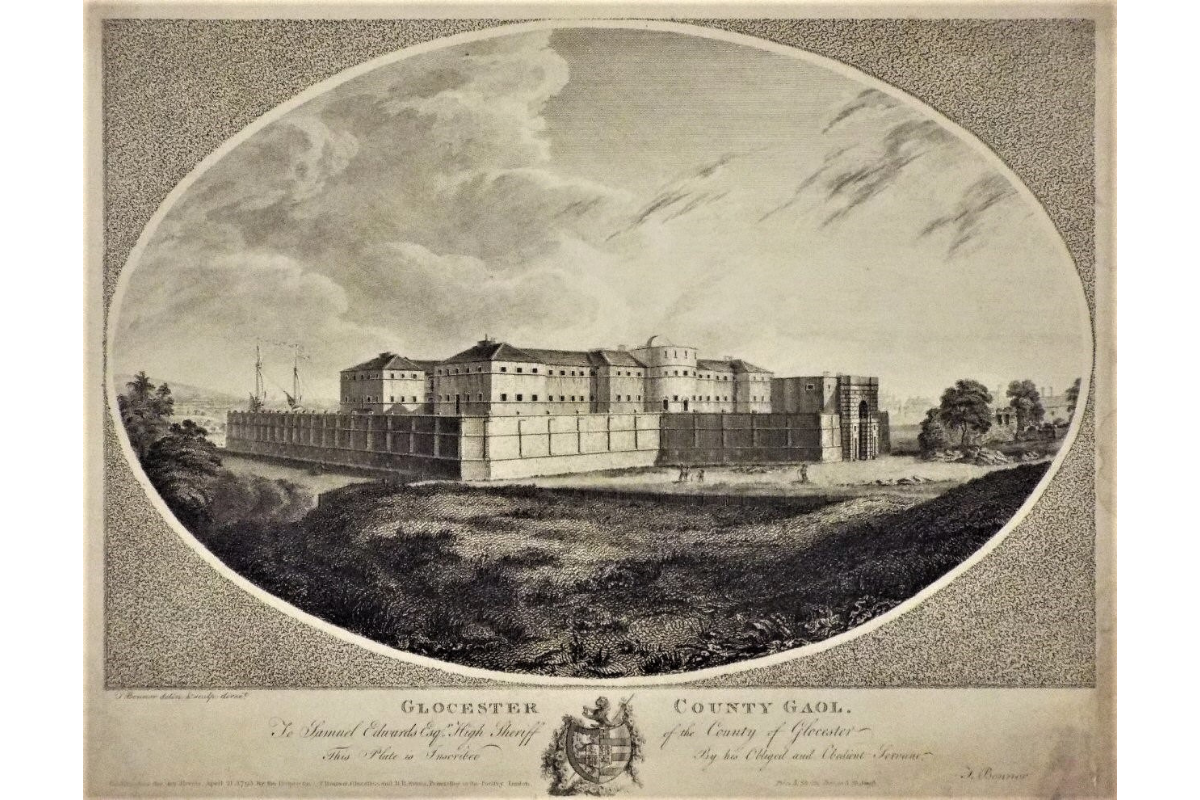
Above: Gloucester County Gaol in 1795, by Thomas Bonnor
At the centre of the site lies the Grade II* listed former Main Prison Building, which along with the Grade II listed former Debtors Prison, Governor’s House and Outer Gatehouse will all be turned into residential use, while the addition of seven sensitively designed new buildings within the grounds will provide additional housing. The result will be a range of contemporary one-, two- and three-bedroom homes with private parking. As part of the redevelopment, the former Chapel in the Main Prison Building will also be turned into community space or potentially a restaurant/café, to provide the vibrant heart of the development and taking in the characterful surroundings of the former prison.
Archaeology
Redevelopment of the former HMP Gloucester has provided a once in a generation opportunity to discover more about Gloucester’s lost medieval castle and the late 18th-century goal that replaced it. In February 2021, Wessex Archaeology excavated a series of trial trenches to determine what below ground remains of these structures survived. Previous archaeological work had already confirmed the location of the medieval keep and other buildings, as well as the substantial foundations of Blackburn’s gaol, but much remained uncertain about the layout of the castle.
One of the key findings of the 2021 evaluation was the discovery of the west wall of the castle’s inner bailey. As expected, a lot of the wall had been carted off for use as road stone in the post-medieval period, but the more deeply buried parts survived as a 2.55 m thick structure hidden beneath 2.2 m of later rubble and soil. To the north of the keep, a further substantial medieval wall was found; it is still unclear what it was used for: it may have been the north wall of the inner bailey, or possibly a large building that abutted the keep. Both walls are probably both contemporary with the early 12th-century keep.
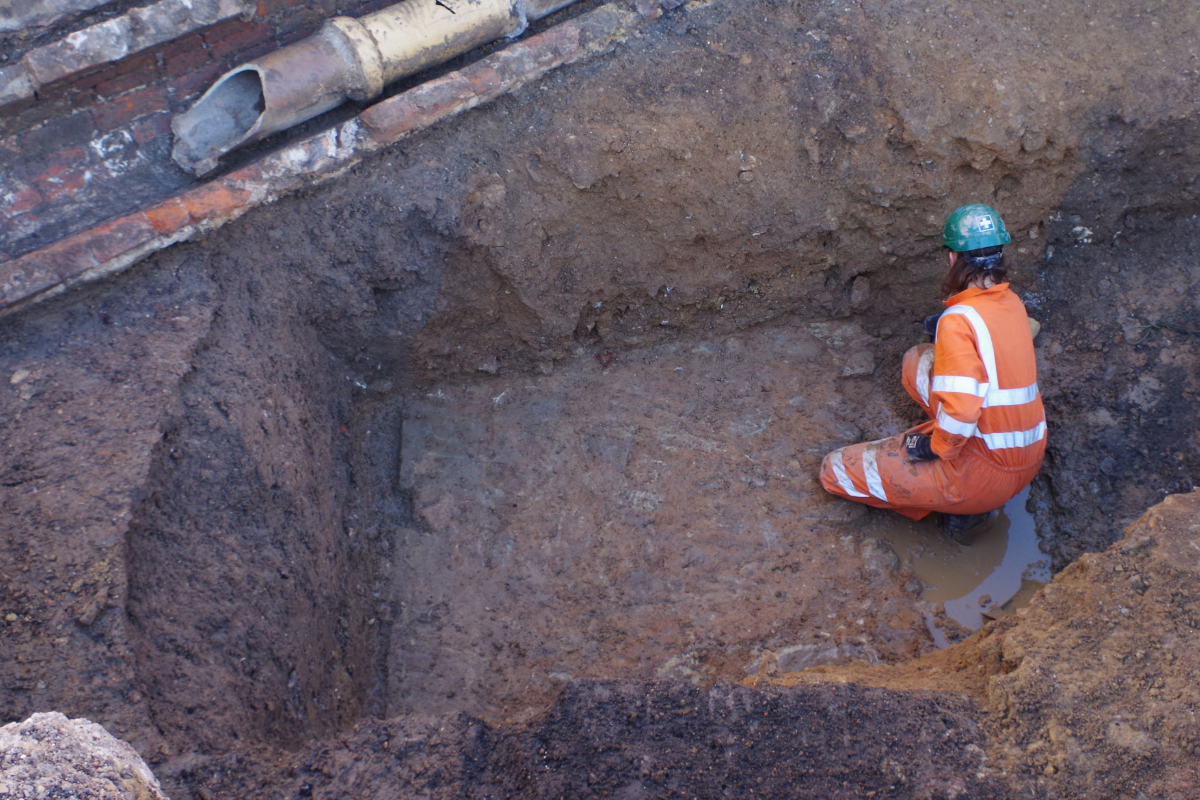
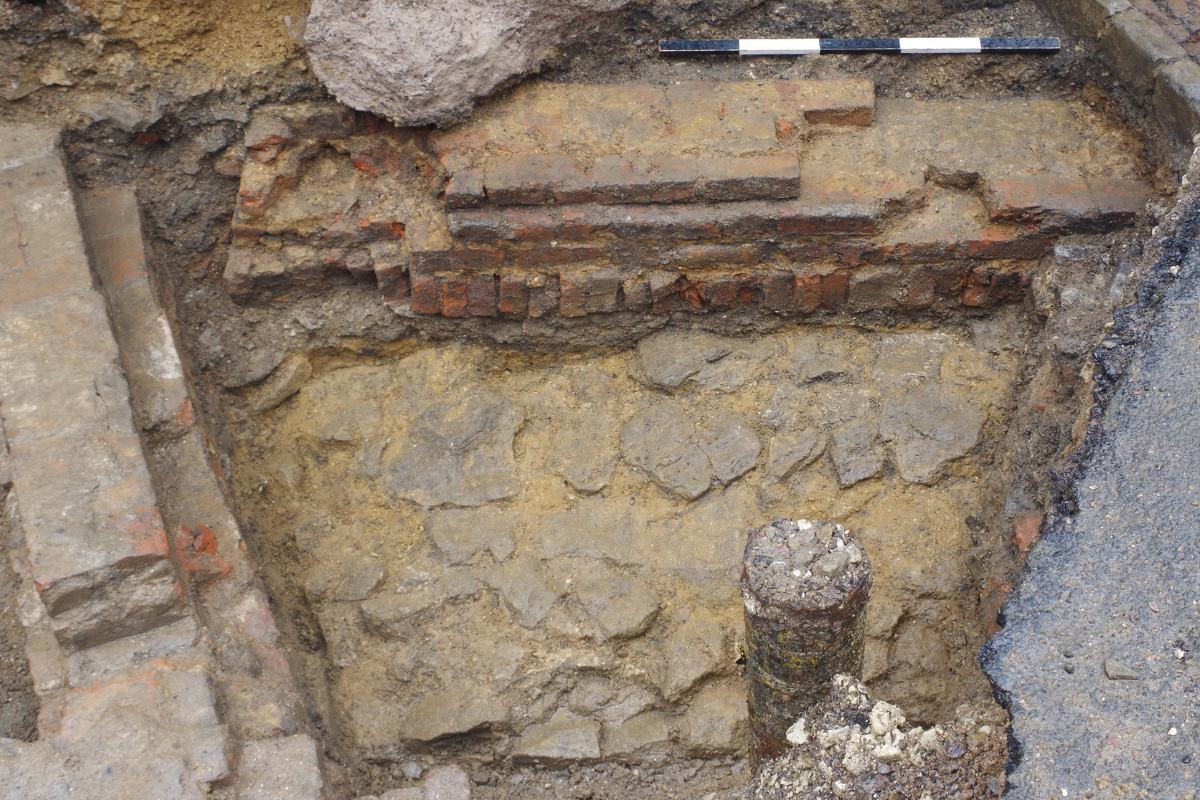
Left: Medieval inner bailey wall of Gloucester Castle
Right: Medieval wall to the north of the keep and foundations of a possible c.1650 bridewell, cut by the wall of a late 18th-century exercise yard
Remains associated with the post-medieval use of the castle as a gaol were also found. These include the foundations of possible gatehouse depicted on Kip’s 1712 Prospect of Gloucester, and brick footings that probably formed part of a c. 1650 bridewell. This type of institution, also known as a ‘house of correction’, was built following the passing of the Elizabethan Poor Law, and were designed to hold petty criminals, vagrants, beggars, and those of ‘loose, idle and disorderly conduct’ for short periods of time. The inmates, two thirds of whom were female, were often sentenced to whipping and most were expected do hard labour.
Remains of Blackburn’s 1792 County Gaol, including the foundations for a massive perimeter wall and the main H-shaped gaol block were also found, as well as the remains of the octagonal Clerk of Works house, which was built into the perimeter wall in the mid-19th century.
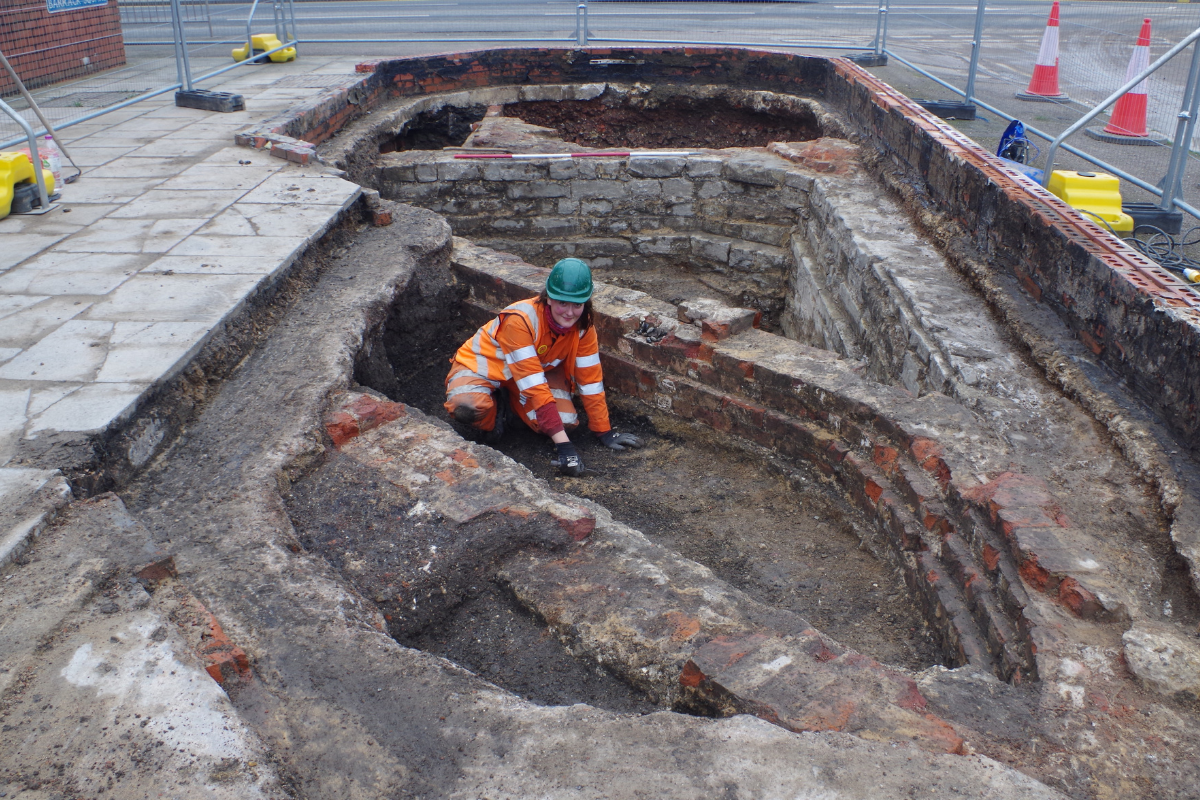
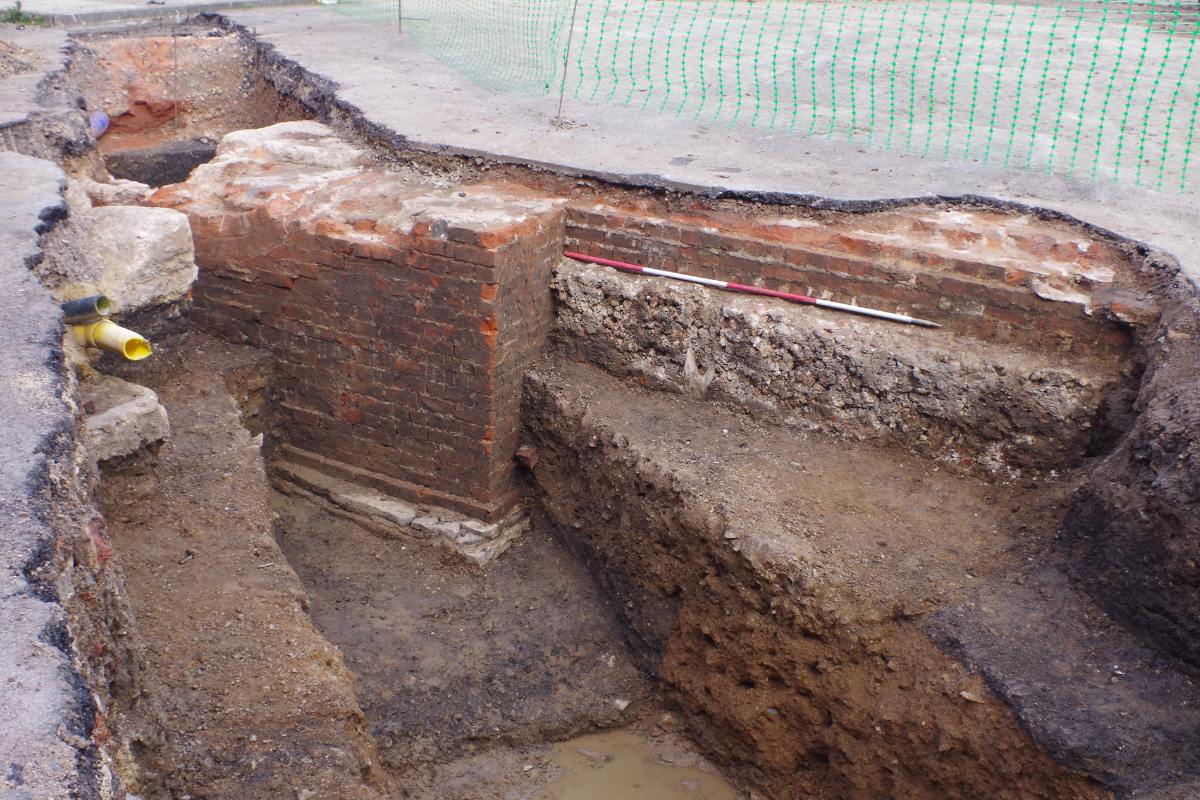
Left: Perimeter wall of Blackburn's 1792 County Gaol and a mid-19th century Clerk of Works House
Right: West wall of Blackburn's 1792 County Gaol
There is still much to discover about Gloucester’s lost castle and the former gaol, and as the development proceeds there are likely to be many more existing discoveries.
To find out more about the development and the history of Gloucester Castle see 1792 The Old Gloucester Gaol and Gloucester Castle during the Second Barons War.
By Cai Mason, Senior Fieldwork Archaeologist
